107 results
Chemistry homework for Easel Assessments and for early intervention

Globally Harmonized System GHS Classification & Labelling of Chemicals Card Sort
A hands-on card sort based on the United Nations Globally Harmonized System (GHS) of Classification and Labelling of Chemicals.Students match each pictogram to its symbol, description of hazard, hazard class, associated hazard statements, recommended prevention and storage, and response to exposure.Includes:GHS template page (1 page)All pictograms (3 pages)54 cards to sort (8 pages)Student Record of Answers (1 page)Answers & printing guide (2 pages) Also includes:Easel ActivitySix auto-gradi
Grades:
8th - 12th, Higher Education
CCSS:
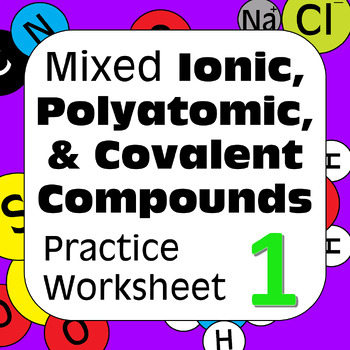
Chemical Nomenclature: Mixed Ionic Polyatomic & Covalent Compounds Practice #1
Practice worksheet containing 40 different compounds: ten binary ionic (monovalent); ten binary ionic (multivalent); ten ternary/polyatomic, and ten covalent. The first of two mixed compounds practice worksheets. Twenty-one questions require the chemical formula, nineteen questions require the chemical name; different question types are mixed.IUPAC-recommended spelling is used.All answers included. This resource includes:1 worksheet (print).1 Easel fillable worksheet (digital).4 Easel multiple-
Subjects:
Grades:
7th - 12th, Higher Education, Adult Education
Types:
NGSS:
HS-PS1-1
, HS-PS1-2
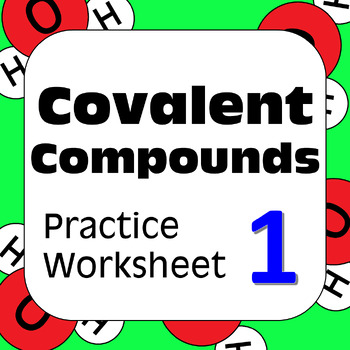
Chemical Nomenclature: Covalent Molecular Compounds Practice Worksheet #1
Practice worksheet containing 40 different covalently bonded compounds. Seventeen questions require the chemical formula, twenty-three questions require the chemical name; different question types are mixed.All compounds are binary; composed of two different nonmetal elements (metalloids included). No ternary/polyatomic ions.Includes multivalent elements.IUPAC-recommended spelling is used.All answers included.This resource includes:1 worksheet (print).1 Easel fillable worksheet (digital).4 Easel
Subjects:
Grades:
7th - 12th, Higher Education, Adult Education
Types:
NGSS:
HS-PS1-1
, HS-PS1-2
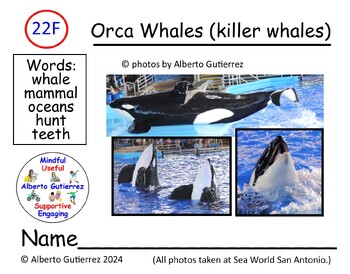
Orca Whales (Killer Whales) #22F
Print 2-sided, cut on horizontal line, fold and staple in middle, each file makes two copies of the same book.This resource introduces kids to some habits and physical characteristics of Orca Whales. Use this book with advanced readers/writers or as an early intervention tool for older students. Kids will have many opportunities to learn interesting facts about Orcas. The back page includes potential guiding questions for both teachers and students.You May Also Like - About Squirrels #31CYou May
Grades:
1st - 3rd

Chemical Nomenclature: Compounds with Polyatomic Ions Practice Worksheet #1
Practice worksheet containing 28 different ternary/polyatomic compounds; the first of two polyatomic compound worksheets. Twelve questions require the chemical formula, sixteen questions require the chemical name.A short list of polyatomic ions and names is included at the top of the page for easy reference.All compounds contain at least one ternary/polyatomic ion. All compounds, therefore, are composed of three or more different elements. Includes multivalent elements.IUPAC-recommended spelling
Subjects:
Grades:
8th - 12th, Higher Education, Adult Education
Types:
NGSS:
HS-PS1-1
, HS-PS1-2
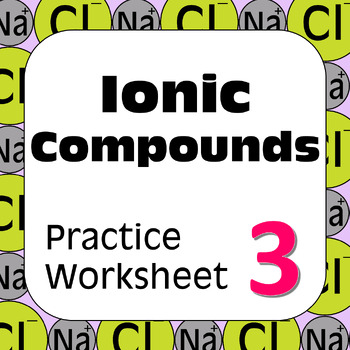
Chemical Nomenclature: Ionic Compounds Practice Worksheet #3
Practice worksheet containing 40 different ionic compounds; the third of three scaffolded ionic compound practice worksheets.Twenty questions require the chemical formula, and twenty questions require the chemical name.One print plus two different digital formats provide all the flexibility needed in one handy resource.All compounds are binary; composed of two different elements, one metal and one nonmetal.Includes multivalent elements.IUPAC-recommended spelling is used.All answers included.This
Subjects:
Grades:
7th - 12th, Higher Education, Adult Education
Types:
NGSS:
HS-PS1-1
, HS-PS1-2
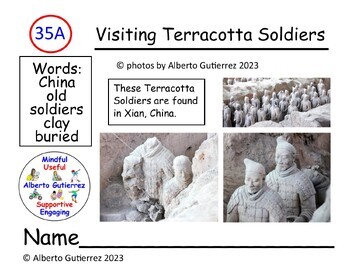
Visiting the Terracotta Soldiers #35A
Print 2-sided, cut, fold, and staple to make a mini-book for each child in your classroom. This file will make two identical books. Take a walk in China with the Terracotta Soldiers in Xian, China. Students will learn through photos, labeling, text, and text boxes about these ancient relics. You May Also Like Pyramids in Egypt #29C.Visit the Great Wall #3AVisiting Cairo, Egypt #7FVisiting the Dead Sea, Jordan #8FVisiting Petra, Jordan #7F
Grades:
K - 3rd
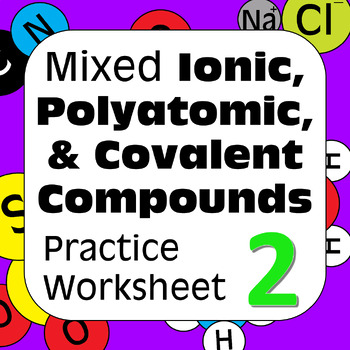
Chemical Nomenclature: Mixed Ionic Polyatomic & Covalent Compounds Practice #2
Practice worksheet containing 40 different compounds: five binary ionic (monovalent); twelve binary ionic (multivalent); twelve ternary/polyatomic, and eleven covalent. The second of two mixed compounds practice worksheets. Eighteen questions require the chemical formula, twenty-two questions require the chemical name; different question types are mixed.IUPAC-recommended spelling is used.All answers included. This resource includes:1 worksheet (print).1 Easel fillable worksheet (digital).4 Ease
Subjects:
Grades:
7th - 12th, Higher Education, Adult Education
Types:
NGSS:
HS-PS1-1
, HS-PS1-2
![Preview of Endothermic and Exothermic Reactions [Easel]](https://ecdn.teacherspayteachers.com/thumbitem/Endothermic-and-Exothermic-Reactions-Easel--9111913-1675718814/original-9111913-1.jpg)
Endothermic and Exothermic Reactions [Easel]
This four-page worksheet explores real-world examples of endothermic and exothermic reactions. Students will connect the prefixes "endo-" and "exo-" to the tangible examples pictured on the worksheet. The goal of the activity is to visualize how heat energy is moving within each system and how that relates to the vocabulary.The activity features 15 scenarios, each with a two-part multiple-choice question. Examples include melting, combustion, freezing, condensation, evaporation, sublimation, coo
Subjects:
Grades:
6th - 8th
Types:

Nonfiction: About Grasshoppers #23A
Introduce beginning readers to backyard insects. This resource shares basic information regarding grasshoppers. There are many photos of grasshoppers. You will also find many labels pointing out some structures of the grasshopper. The labels will help show young writers that they too can add labels to their own writing. For young learners, writing and reading can be exciting. Please use this book as a model for your kids. The targeted audience is Kindergarten students, but this resource can be u
Grades:
K - 3rd
Also included in: Insect Bundle Readers 9 Books
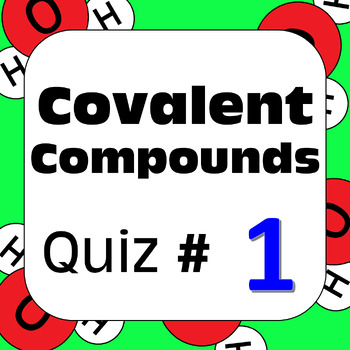
Chemical Nomenclature: Covalent Molecular Compounds Quiz #1
Assessment quiz containing 10 different covalent compounds; the first of seven covalent compound quizzes for chemical nomenclature. Five questions identify the chemical name and require the chemical formula.Five questions identify the chemical formula and require the chemical name.All compounds are binary; composed of two different nonmetal elements (metalloids included). No ternary/polyatomic ions.IUPAC-recommended spelling is used.All answers included.This resource includes:1 worksheet (print)
Subjects:
Grades:
7th - 12th, Higher Education, Adult Education
Types:
NGSS:
HS-PS1-1
, HS-PS1-2
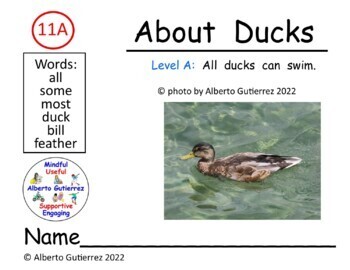
Level A Nonfiction: About Ducks #11A
Print 2-sided, cut on horizontal line, fold and staple in middle, each file makes two copies of same book. (Now with page numbers)Use for Kindergarten as introduction to reading or as an early intervention tool for older kids. This book looks at the sentences beginning with "Some, Most, All...." patterns. Each page has a main photo and labels to help children see how labeling can be done in their own writing. Whenever possible provide writing and reading opportunities often because a young lea
Subjects:
Grades:
K - 3rd
Also included in: Level A: Repeating Pattern Books Fiction #1- #5 & Nonfiction #6- #11

Chemical Nomenclature: Compounds with Polyatomic Ions Practice Worksheet #2
Practice worksheet containing 34 different ternary/polyatomic compounds; the second of two polyatomic compound worksheets. Nineteen questions require the chemical formula, fifteen questions require the chemical name; different question types are mixed.All compounds contain at least one ternary/polyatomic ion. All compounds, therefore, are composed of three or more different elements. Includes multivalent elements.IUPAC-recommended spelling is used.All answers included.This resource includes:1 wo
Subjects:
Grades:
8th - 12th, Higher Education, Adult Education
Types:
NGSS:
HS-PS1-1
, HS-PS1-2
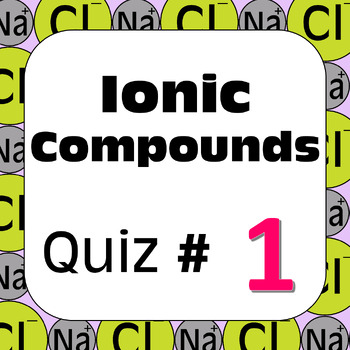
Chemical Nomenclature: Ionic Compounds Quiz #1
Assessment quiz containing 10 different ionic compounds; the first of seven ionic compound quizzes for chemical nomenclature. Five questions identify the chemical name and require the chemical formula.Five questions identify the chemical formula and require the chemical name.All compounds are binary; composed of two different elements, one metal and one nonmetal (no ternary/polyatomic ions).Includes multivalent elements.IUPAC-recommended spelling is used.All answers included.This resource includ
Subjects:
Grades:
7th - 12th, Higher Education, Adult Education
Types:
NGSS:
HS-PS1-1
, HS-PS1-2

Nonfiction: About Wasps #22A
Print 2-sided, cut on horizontal line, fold and staple in middle, each file makes two copies of the same book. (Full text of book found below.)You May Also Like - About Bees #8AYou May Also Like - Insect Bundle Readers 9 BooksUse this book for advanced Kindergarten readers. Or use it as an early intervention tool for older kids. This book illustrates some interesting information about wasps. The reader will find colorful photos and facts about wasps. For advanced readers or those interested in m
Grades:
K - 3rd
Also included in: Level A Readers: 11 Books #12A - #22A

Level A: About Horses #9A
Print 2-sided, cut on horizontal line, fold and staple in middle, each file makes two copies of same book. (page numbers now included.)You May Also Like - Bumblebees and Honeybees #24AYou May Also Like - About Grasshoppers #23AYou May Also Like - About Spiders #7AThis resource shows young learners how to apply labels and facts within their own writing activities. You may also like Guiding Each Child Through the Writing Process for young learners.Use for Kindergarten as introduction to reading or
Subjects:
Grades:
K - 3rd
Also included in: Level A: Repeating Pattern Books Fiction #1- #5 & Nonfiction #6- #11
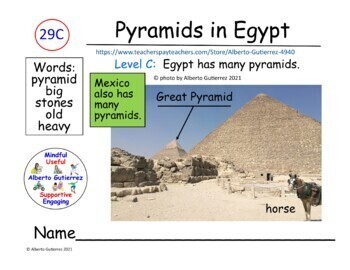
Pyramids in Egypt: Computer Reading #29C
Please use this resource with each of your students in your classroom. Keep young learners reading via home internet. This resource will keep readers reading at home. You are encouraged to send a copy to each child in your classroom. Then, kids will have multiple opportunities to read at home. This resource may be read on computer, tablet, or phone.This is a companion to the small book Pyramids in Egypt #29CIntroduce beginning readers to ancient structures. Kids will see photos of the Great Pyra
Grades:
K - 3rd
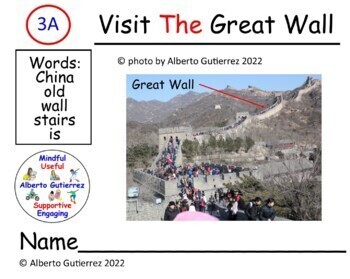
Nonfiction: Visit The Great Wall #3A
Print 2-sided, cut on horizontal line, fold and staple in middle, each file makes two copies of same book. The full text found below: Please read before use with your kids.Use this book to introduce students to world heritage sites. Kids will read about the Great Wall in China. There are many photos and facts for all young learners. Use with Kindergarten students or as an early intervention tool for older kids. Students of English as a second language will also find this book useful. There are m
Grades:
K - 3rd

About Spiders Nonfiction: Long Distance Learning #7A
Please use this resource with each of your students in your classroom. Keep young learners reading via home internet. This resource will keep readers reading at home. This version can be read on computer, tablet, or phone. You are encouraged to send a copy to each child in your classroom. Then, kids will have multiple opportunities to read at home. This resource can be read on computer, tablet, or phone. File is not designed for 2-sided printing.This is a companion to the small book About Spider
Grades:
K - 3rd
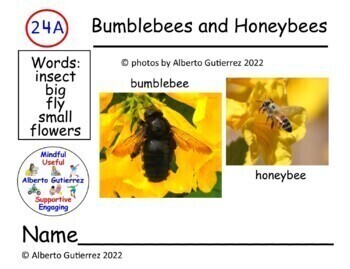
About Bumblebees and Honeybees #24A
Introduce beginning readers to backyard insects. This resource shares basic information regarding bumblebees and honeybees. You will find many labels pointing out some structures of the bumblebee and the honeybee. The labels will help show young writers that they too can add labels to their own writing. Please use this book as a model for your kids. The targeted audience is Kindergarten students, but this resource can be used as an early intervention tool for older kids and nonnative English lea
Grades:
K - 3rd
Also included in: Insect Bundle Readers 9 Books
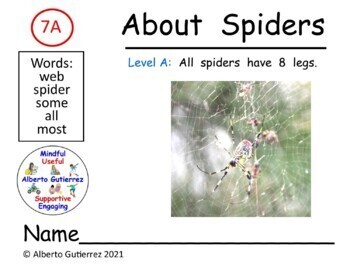
Nonfiction: About Spiders #7A
Use for Kindergarten as introduction to reading or as an early intervention tool for grades 1, 2, 3. This book looks at the sentences beginning with "Some, Most, All...." patterns. Each page has a main photo and labels with the main photo to help children see how labeling can be done in their own writing. Hint: whenever possible provide writing and reading opportunities often and integrated because a young learner needs to develop both reading and writing skills early for success! This resour
Subjects:
Grades:
K - 3rd
Also included in: Level A: Repeating Pattern Books Fiction #1- #5 & Nonfiction #6- #11

About Horses for Computer Reading: #9A
Please use this resource with each of your students in your classroom. Keep young learners reading via home internet. This resource will keep readers reading at home. You are encouraged to send a copy to each child in your classroom. Then, kids will have multiple opportunities to read at home. This resource may be read on computer, tablet, or phone. File is not formatted for 2-sided printing. It can be printed single side.This is a companion to the small book About Horses #9AYou May Also Like -
Grades:
K - 3rd
Types:
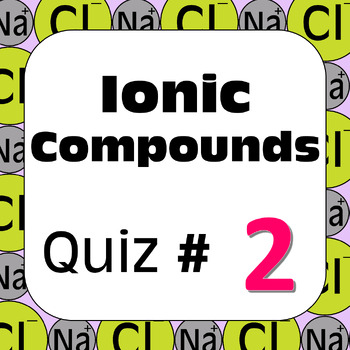
Chemical Nomenclature: Ionic Compounds Quiz #2
Assessment quiz containing 10 different ionic compounds; the second of seven ionic compound quizzes for chemical nomenclature. Five questions identify the chemical name and require the chemical formula.Five questions identify the chemical formula and require the chemical name.All compounds are binary; composed of two different elements, one metal and one nonmetal (no ternary/polyatomic ions).Includes multivalent elements.IUPAC-recommended spelling is used.All answers included.This resource inclu
Subjects:
Grades:
7th - 12th, Higher Education, Adult Education
Types:
NGSS:
HS-PS1-1
, HS-PS1-2
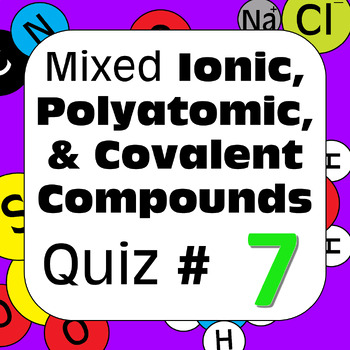
Chemical Nomenclature: Mixed Ionic Polyatomic & Covalent Compounds Quiz #7
Assessment quiz containing 10 different mixed ionic, polyatomic, & covalent compounds; the seventh of seven mixed compound quizzes for chemical nomenclature. Five questions identify the chemical name and require the chemical formula.Five questions identify the chemical formula and require the chemical name.Contains a mixture of binary ionic, ternary/polyatomic, and covalently bonded compounds.Includes multivalent elements.IUPAC-recommended spelling is used.All answers included.This resource
Subjects:
Grades:
7th - 12th, Higher Education, Adult Education
Types:
NGSS:
HS-PS1-1
, HS-PS1-2
Showing 1-24 of 107 results

